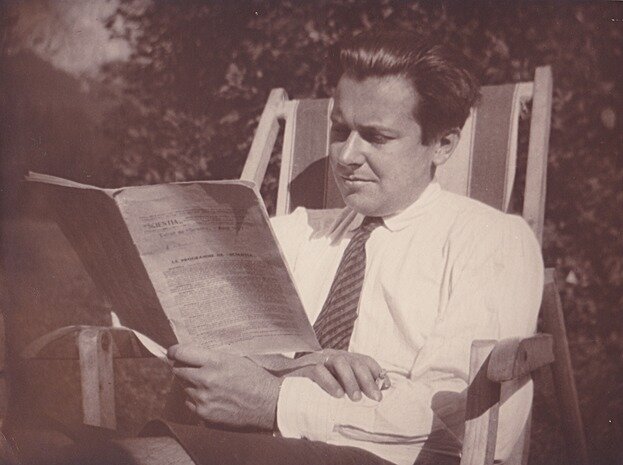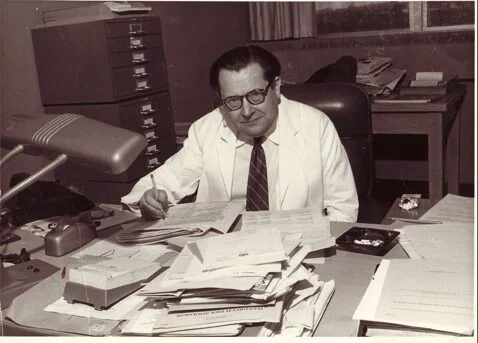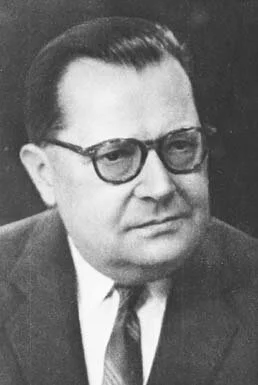Karl Ludwig von Bertalanffy
Childhood
Karl Ludwig von Bertalanffy (September 19, 1901, Atzgersdorf - June 12, 1972, New York) was an Austrian biologist who grew up in the little village of Atzgersdorf near Vienna and subsequently worked in Vienna, London, Canada and the United States. He came from a distinguished family which included many scholars and court officials. Ludwig grew up as an only child educated at home by private tutors until he was ten.
Academic career
In 1918, Bertalanffy started his studies at the university level in philosophy and art history, first at the University of Innsbruck and then at the University of Vienna. In 1926 he finished his PhD thesis (Fechner and the Problem of Higher-Order Integration). Bertalanffy as a young scholar was not only interested in biology and philosophy of science. He was also interested in history and generally in humanities. In 1934 he became a professor of theoretical biology at the University of Vienna and one of the leading exponents of the organismic point of view in biology. This point of view opposed mechanistic explanations of living processes.
In 1948 he left war ravaged Vienna. He went first to England and spent some time with Julian Huxley at the University of Cambridge and with Joseph Woodger at the University of London. From England in 1949 he went to the University of Ottawa in Canada where he became the director of the Research Department of Biology. Between 1954-1955 he was a senior fellow at the Center for Advanced Study in Behavioral Sciences at Stanford. Next, he became the director of cancer research division of Mt. Sinai Hospital in Los Angeles. Afterwards he went as a visiting fellow to the Menninger Foundation in Topeka, Kansas, where he did some work on the problems of mental illness. In 1961 he returned to Canada as the professor of theoretical biology at the University of Alberta. While at that university von Bertalanffy, in keeping with his interdisciplinary approach to the problems of human knowledge held a joint appointment in the departments of Zoology, Psychology, and Philosophy. He was one of the founding members of the Center for Advanced Study of Theoretical Psychology at the University of Alberta. In 1969 he left Alberta to join the staff of the newly formed Center for Theoretical Biology at the University of Buffalo, N.Y.
In 1972 Buckminster Fuller was asked by a committee of French scientists to write a paper on Ludwig von Bertalanffy's nomination for the Nobel Prize. He did so. The nomination went to Oslo, but the committee's effort came just too late. Ludwig died from a heart attack before the nomination of him could be considered by the Nobel authorities. He was buried in Montreal.



General Systems Theory
Systems theorists see reality as too complex for a clear cause-effect relationship. They see reality as a system, as interconnected elements that influence each other, and emphasize its relational networking. Every change to a part of the system affects the entire system. Humans are not just a system in themselves that processes information, for example. The human being is also an element, a component of other systems, such as a partnership, a family, an organization and society. In this sense, a family, company or organization is more than just the sum of the characteristics of its members. The whole thing is more than the sum of its parts. Bertalanffy is one of the founders of general systems theory (GST). GST is an interdisciplinary practice that describes systems with interacting components, applicable to biology, cybernetics, and other fields. Bertalanffy proposed that the laws of thermodynamics applied to closed systems, but not necessarily to "open systems," such as living things. His mathematical model of an organism's growth over time, published in 1934, is still in use today.
“We are seeking another basic outlook: the world as an organization.
This would profoundly change categories of our thinking and influence our practical attitudes. We must envision the biosphere as a whole with mutually reinforcing or mutually destructive inter-dependencies.”
Ludwig von Bertalanffy, a distinguished biologist, occupies an important position in the intellectual history of the twentieth century. His contributions went beyond biology, and extended to psychology, psychiatry, sociology, cybernetics, history and philosophy. Some of his admirers even believe that von Bertalanffy's general systems theory could provide a conceptual framework for all these disciplines. There are two kinds of thinkers, scholars and scientists. The first are the 'trail blazers' who propose new revolutionary ideas, point to new directions for scientific and intellectual developments, create new paradigms of science and scholarship, but leave the details to others. The second are those who follow the new trail, carry out careful experimentation and research within the established paradigm, and work out the precise formulations of theories in a particular domain of knowledge. Ludwig von Bertalanffy, who was both a scientist and a scholar, represented the first kind, he was a 'trail blazer.' He was critical of the 'Cartesian' cult of analytical thinking which prevailed in modern science and philosophy. He suggested that it should be replaced by the holistic systems approach. In some respects, he retreated from the Cartesian-Galilean paradigm of science, which became predominant in the seventeenth century, and went back to the neo-Platonist paradigm of the sixteenth century. Von Bertalanffy's views may be described as a dialectical synthesis bridging the contradictions between the vague holistic theorizing of the sixteenth century neo-Platonists and the constricted, narrow view of reality characteristic of the Cartesian-Galilean science, and that of the Empiricist and Rationalist philosophies of the seventeenth and the eighteenth centuries. This narrow view of reality has characterized the positivistic tradition in science and philosophy, and also the contemporary analytical philosophy.


